#Monica Sjöö
Text
“World myths, folk traditions, and anthropological studies agree that women first discovered how to use and produce fire. In a survey of 224 modern tribal societies, it was found that fires were made and tended always or usually by women in 84 societies; almost all these societies have legends telling of the early times when women were the exclusive "owners" of fire. Ritual maintenance of fire remained entrusted to women down through historic times, such as the Vestal Virgins of ancient Rome, or the Irish nuns of St. Brigid (from the originally Celtic Goddess Brigid, or Bride), who tended a perpetual fire at Kildare until the suppression of the monasteries under Henry VIII. Fire is sacred to the Moon Mother. Cooking—boiling, roasting, baking, steaming—was only one of the techniques women acquired from their mastery of directed heat. Fire was the tool of tools; through its use foods could be dried and conserved for future use, and some poisonous plants and fruits made edible. It was women who developed all the early associated industries of cooking and ceramics in which fire was the critical tool.”
-Monica Sjöö and Barbara Mor. The Great Cosmic Mother: Rediscovering The Religion of the Earth.
826 notes
·
View notes
Text
In the beginning ... was a very female sea. For two-and-a-half billion years on earth, all life-forms floated in the womb-like environment of the planetary ocean—nourished and protected by its fluid chemicals, rocked by the lunar-tidal rhythms. Charles Darwin believed the menstrual cycle originated here, organically echoing the moon-pulse of the sea. And, because this longest period of life's time on earth was dominated by marine forms reproducing parthenogenetically, he concluded that the female principle was primordial. In the beginning, life did not gestate within the body of any creature, but within the ocean womb containing all organic life. There were no specialized sex organs; rather, a generalized female existence reproduced itself within the female body of the sea.
Before more complex life forms could develop and move onto land, it was necessary to miniaturize the oceanic environment, to reproduce it on a small and mobile scale. Soft, moist eggs deposited on dry ground and exposed to air would die; life could not move beyond the water-hugging amphibian stage. In the course of evolution, the ocean—the protective and nourishing space, the amniotic fluids, even the lunar-tidal rhythm—was transferred into the individual female body. And the penis, a mechanical device for land reproduction, evolved.
The penis first appeared in the Age of Reptiles, about 200 million years ago. Our archetypal association of the snake with the phallus contains, no doubt, this genetic memory. This is a fundamental and recurring pattern in nature: Life is a female environment in which the male appears, often periodically, and by the female, to perform highly specialized tasks related to species reproduction and a more complex evolution.
.... Among mammals, even among humans, parthenogenesis is not technically impossible. Every female egg contains a polar body with a complete set of chromosomes; the polar body and the egg, if united, could form a daughter embryo. In fact, ovarian cysts are unfertilized eggs that have joined with their polar bodies, been implanted in the ovarian wall, and started to develop there.
This is not to say that males are an unnecessary sex. Parthenogenesis is a cloning process. Sexual reproduction, which enhances the variety and health of the gene pool, is necessary for the kind of complex evolution that has produced the human species. The point being made here is simply that, when it comes to the two sexes, one of us has been around a lot longer than the other.
—Monica Sjöö & Barbara Mor, "The Great Cosmic Mother: Rediscovering the Religion of the Earth."
47 notes
·
View notes
Text

God Giving Birth (1968) by Monica Sjöö
18 notes
·
View notes
Text
"The Great Mother was the projection of the self-experience of groups of highly aware and productive women who were the founders of much of human culture. In this sense, the Great Mother is not simply a mental archetype, but a historical fact. Ancient icons, symbols, and myths cannot be understood if they are disembodied from this fact. They... must be seen in the context of ancient political realities."
"Because the Great Mother was a historical reality, her psychological repression must also be seen in historical terms, as a political suppression of an earlier female-oriented world order by a later male-dominated one."
-- The Great Cosmic Mother, by Barbara Mor and Monica Sjöö, p. 30 and 31
#the great cosmic mother#barbara mor#monica sjöö#goddess#matriarchy#seal womyn reads#herstory blogging#this is such an incisive way to sum up how i look at my goddess research#the book has been a mixed bag so far but interested to finish it#this also relates to why all poisoned male-usurped cultures need rematriation#goddess blogging
127 notes
·
View notes
Text
"For this is precisely what patriarchy sets out to do: to split material production from spiritual experience, science from magic, medicine from herbal knowledge and psychic/seasonal environment, sexuality from the sacred, art from craft, astronomy from astrology, language from poetry-- and to place the resultant "specialized", abstracted, and mechanistic knowledge in the hands of a privileged male elite organized into professions, hierarchies, and classes. To reduce the ecstatic dance of muscle, blood, and soul to factory assembly lines, production output schedules, and the gross national product."
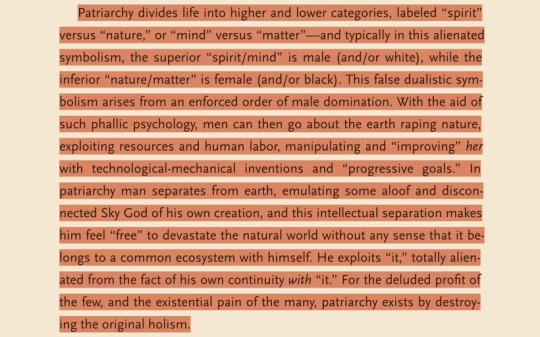
2 notes
·
View notes
Text
"The mystery of earthly life has its origins in water-in oceans, deep lakes, and shallow pools, cave grottoes and streams, and rivers; in the sea-like pulse and taste of blood."
Monica Sjöö & Barbara Mor, The Great Cosmic Mother, 1987
#monica sjöö#barbara mor#the great cosmic mother#poetry#poem#writing#words#quote#dark academia quote#dark academia writing#dark academia poetry#aesthetic#dark academia poem#dark academia#spilled writing#spilled poetry#spilled ink#spilled words#spilled thoughts#spilled poem#monica sjöö poetry#barbara mor poetry#monica sjöö poem#barbara mor poem#monica sjöö writing#barbara mor writing#monica sjöö quote#barbara mor quote
17 notes
·
View notes
Text

(The Amulet - Joseph Coomans/Detail)
* * * *
“The witch-burnings did not take place during the ‘Dark Ages,’ as we commonly suppose. They occurred between the fifteenth and eighteenth centuries– precisely during and following the Renaissance, that glorious period when, as we are taught, ‘men’s’ minds were being freed from bleakness and superstition. While Michelangelo was sculpting and Shakespeare writing, the witches were burning. The whole secular ‘Enlightenment,’ in fact, the male professions of doctor, lawyer, judge, artist, all rose from the ashes of the destroyed women’s culture. Renaissance men were celebrating naked female beauty in their art, while women’s bodies were being tortured and burned by the hundreds of thousands all around them.”
- Monica Sjöö & Barbara Mor, The Great Cosmic Mother: Rediscovering the Religion of the Earth (1987)
(Guillaume Gris)
#women#quotes#Monica Sjöö & Barbara Mor#The Great Cosmic Mother#The Amulet#Joseph Coomans#Guillaume Gris
21 notes
·
View notes
Text
It's not bad enough they let works by men into a Women’s Art exhibit but they features these freaks?
By Genevieve Gluck December 30, 2023
A prestigious art museum in London has prompted backlash after featuring trans-identified males in a historical exhibition of the women’s liberation movement. The Women in Revolt! exhibit is a first of its kind project offering “a wide-ranging exploration of feminist art” made by over 100 female artists during the period between 1970 – 1990.
While the exhibit purports to amplify the work of women, some female visitors to the museum quickly noticed that a number of trans-identified males had been slipped in among the displays.
One of the most disturbing pieces include archival copies of a publication created by men with a sexual fetish for pretending to be women, including one letter from a transvestite who complains of being jealous of his wife.
“Once I had admitted my true inner self to others I felt great relief, and thereupon decided to be myself all the time and live life as it suited me and not as the way I had been committed to live since coming out of the womb,” reads the letter, written by a man identified as “Julia.”


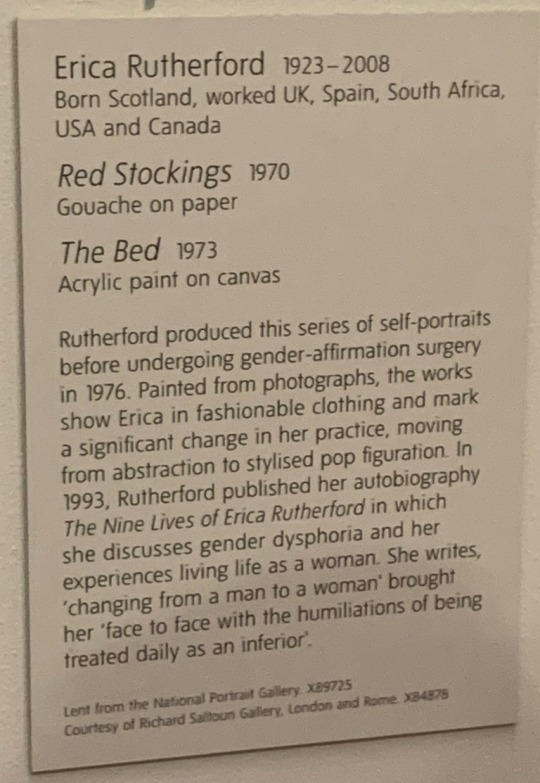

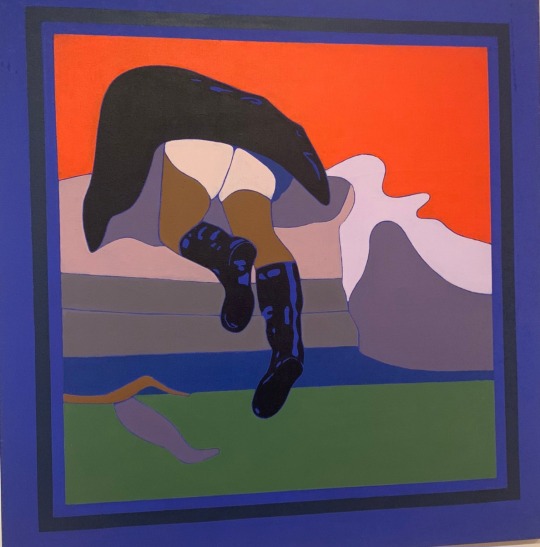
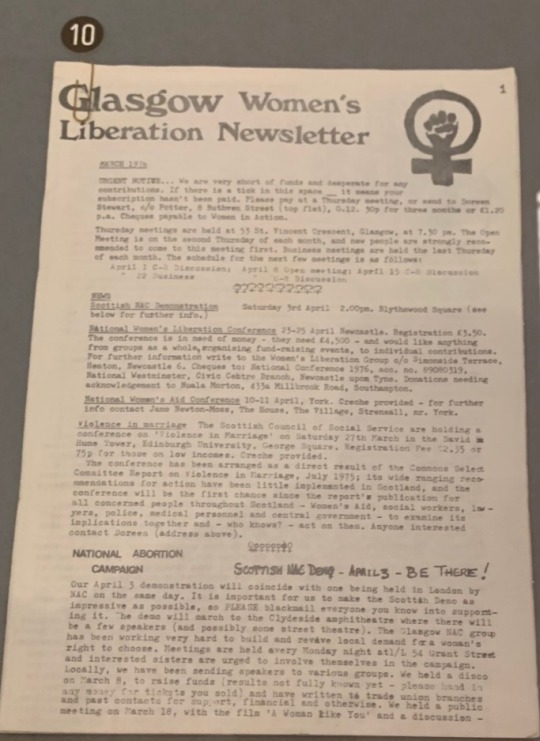
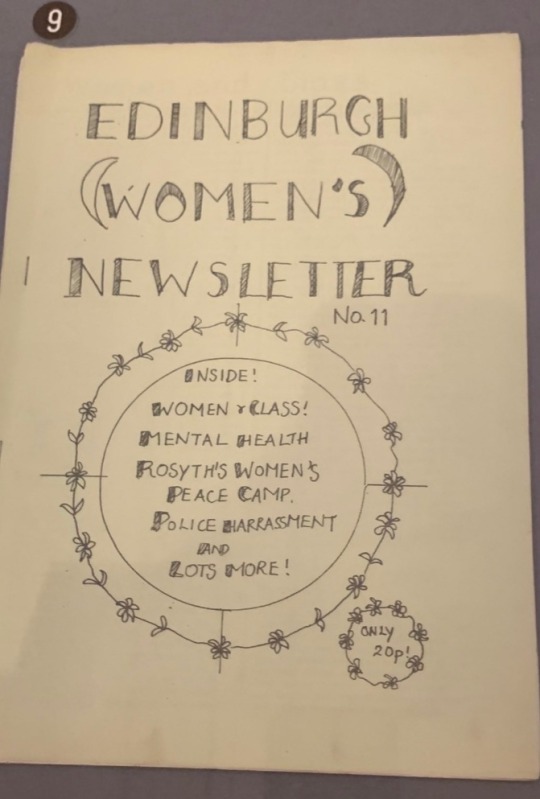


“Prior to this, my marriage (to a woman), had broken up and my wife was seeking a divorce together with the custody of the children because of my attitude to life, namely brought about because of my jealousy of her femininity and her ability to become pregnant and know true happiness within the straight society.”
The admission was one of several personal anecdotes contained within a magazine primarily catering to gay men called “Come Together.”
Information on the exhibit was first posted to X by women’s rights advocate @Sorelle_Arduino, who visited the exhibit yesterday and uploaded photos to her social media showing displays featuring trans-identified males.
One of the photos snapped by the user was an abstract painting by transgender artist Erica Rutherford displayed next to Monica Sjöö’s iconic piece “Wages for Housework.” In the display’s description of Rutherford’s painting, it states that he was inspired by being brought “face to face with the humiliations” of being treated as a woman.
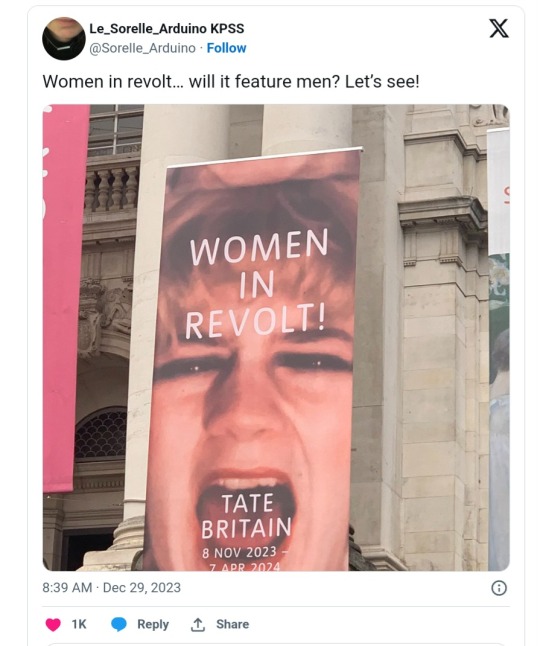
“No cultural womens event can happen any more without men. Art has become a simpering pile of conformist junk,” one user said in response to @Sorelle_Arduino‘s thread on the exhibit.
“It would be bigoted to talk about women without talking about the ones that are men,” another quipped sarcastically.
Other displays featured articles from newsletters produced by the Beaumont Society, a group created in order to advocate for heterosexual crossdressers to be allowed to practice their sexual fetish publicly.
Among their goals, according to the group’s website, is to “promote and assist the study of gender.” The lobby organization uses as its namesake the 18th century French nobleman Charles Chevalier d’Éon de Beaumont, who would assume the identity of a woman named Charlotte, and was officially recognized as a woman by King Louis XVI.
The Beaumont Society, which currently advocates for the medical ‘transitioning’ of minors, was founded in 1966 by four male transvestites, one of whom was a leading figure in the fetish movement in the United States. Virginia Charles Prince, born Arnold Lowman, aided in creating the organization as a branch of a secret society of transvestic fetishists, who called themselves Full Personality Expression (FPE), located in California.
Initially, the group, as well as others like it which began to spring up in the United Kingdom, the United States, and Australia at the time, refused membership to homosexuals, presumably on the basis that prominent transvestites did not want the practice associated with sexual motivations. In one newsletter printed by Virginia Prince, who is credited with having popularized the term ‘transgender,’ he writes: “Some of the more narrow-minded of our sister TV’s [transvestites] see nothing good in anything that homosexuals do, but personally I am all for their success and would cooperate in helping them to achieve it where I could out of pure self-interest for our group.”
Prince has also openly discussed the sexual nature of the crossdressing fetish. In 1985 he appeared in an HBO documentary titled, “What Sex am I?”, where he commented on the element of arousal involved, saying that it was a “turn on” for “almost everybody” who participates.
“You have to grow past the stage of being an erotically aroused male in a dress, which results eventually in an orgasm. But when the orgasm is over, if you continue to stay in the dress, you begin to discover there’s this other part of yourself. You cease being an erotically aroused male, and you simply become a man who becomes to recognize that, gee, there’s something nice about girlness that I’m enjoying experiencing,” Prince, a co-founder of The Beaumont Society, said.
In recent years The Beaumont Society has become increasingly influential within the government and the medical establishment. The group is listed as an advisor to the National Health Service (NHS) in England as well as in Wales.
This is not the first controversy involving the Tate Museum centering trans-identified males, with multiple incidents occurring over the past year that have raised concerns amongst women’s rights advocates.
In June, a trans activist known for staging protests involving human urine was invited to read poetry during the Queer and Now LGBTQIA+ art festival. Jamie Cottle was dressed in women’s lingerie during the reading, wearing white panties that had the words “Sugar Money” embroidered into the crotch.
Though Cottle’s presentation was said to be for ages 16 and up, there were even younger children in attendance in the nearby area, with no boundaries set up to prevent minors from entering.
#UK#Tate Museum#Women In Revolt!#Its not Revolting Men#The Beaumont Society#Full Personality Expression (FPE)
21 notes
·
View notes
Text
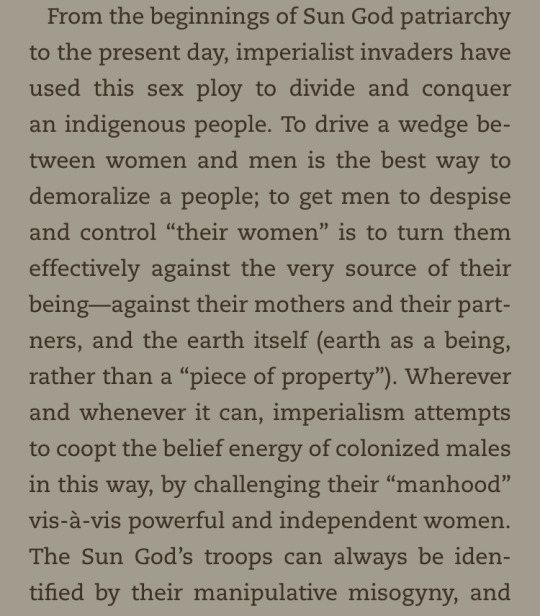
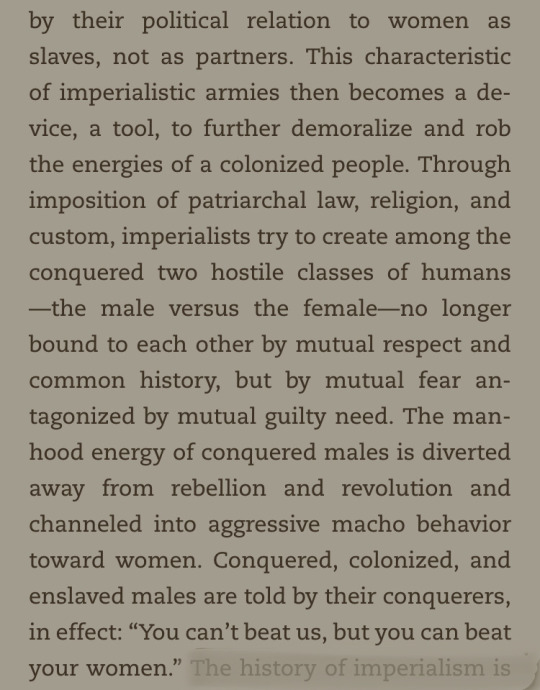
“You can’t beat us, but you can beat your women”
The Great Cosmic Mother | Monica Sjöö & Barbara Mor.
#Barbara Mor#Monica Sjoo#the great cosmic mother#patriarchy#indigenous people#gender wars#imperialism#misogynoir#misogony#black manosphere#femicide
57 notes
·
View notes
Text
“The witch-burnings did not take place during the ‘Dark Ages,’ as we commonly suppose. They occurred between the fifteenth and eighteenth centuries– precisely during and following the Renaissance, that glorious period when, as we are taught, ‘men’s’ minds were being freed from bleakness and superstition. While Michelangelo was sculpting and Shakespeare writing, the witches were burning. The whole secular ‘Enlightenment,’ in fact, the male professions of doctor, lawyer, judge, artist, all rose from the ashes of the destroyed women’s culture. Renaissance men were celebrating naked female beauty in their art, while women’s bodies were being tortured and burned by the hundreds of thousands all around them.”
- Monica Sjöö & Barbara Mor, The Great Cosmic Mother: Rediscovering the Religion of the Earth (1987)
(Guillaume Gris)
#dark academia#light academia#humans#humanity#humankind#witches#witchcraft#dark ages#renaissance#anthropology#history#ancient history
6 notes
·
View notes
Text
Mary is wife, mother, and child to the same male power-figure. She is utterly meek, abject, passive. In her, the ancient power of the Goddess is captured, chained, used, cannibalized — "metaphysically cannibalized," in Ti-Grace Atkinson's critical phrase — domesticated and tranquilized. It is no accident that Mary is portrayed as giving birth in tranquility and bliss, as a reward for her asexuality and total submission (thus "redeeming" the crime of Eve)—while Christ, her son, takes on the suffering and dramatic childbearing role of the Mother. For he twists on the cross in labor, to give birth to a redeemed human race. Pierced by a soldier's sword, blood and water pour from his body—exactly as from a woman in childbirth. The figure displayed on the crucifix in Catholic churches particularly is a male parody of the female experience—of menstrual bleeding, of childbirth, of ontological physical suffering for the human race. But while Christ coopts this female experience into his own power and glory—women, who really do these things, have been forced to hide the signs of our bleeding and childbed "crucifixions" as unclean processes, and badges of corruption, inferiority, and shame. The deified male martyr flaunts his "sacrifice" everywhere, and we are supposed to bow down to it. Women, the real thing, are required by "decency" to hide our messiness out of sight.
-Monica Sjöö and Barbara Mor. The Great Cosmic Mother: Rediscovering The Religion of the Earth.
436 notes
·
View notes
Text
Colonialism is a form of vampirism that empowers and bloats the self-image of the colonizing empire by draining the life energies of the colonized people; just enough blood is left to allow the colonial subject to perform a day’s work for the objective empire. And these drained energies are not only of the present and future, but of the past, of memory itself: the continuity of identity of a people, and of each individual who is colonized.
No one should recognize this process better than women; for the female sex has functioned as a colony of organized patriarchal power for several thousand years now. Our brains have been emptied out of all memory of our own cultural history, and the colonizing power systematically denies such a history ever existed. The colonizing power mocks our attempts to rediscover and celebrate our ancient matriarchies as realities. In the past women have had to accept this enforced female amnesia as “normal”; and many contemporary women continue to believe the female sex has existed always and ab aeterno as an auxiliary to the male-dominated world order. But we continue to dig in the ruins, seeking the energy of memory; believing that the reconstruction of women’s ancient history has a revolutionary potential equal to that of any political movement today.
—Monica Sjöö & Barbara Mor, "The Great Cosmic Mother: Rediscovering the Religion of the Earth."
#monica sjöö#feminism#radical feminism#radblr#patriarchy#womanism#marxist feminism#colonialism#anti imperialism
33 notes
·
View notes
Text

Monica Sjöö | The Great Cosmic Mother https://www.artlimited.net/agenda/monica-sjoo-the-great-cosmic-mother-exhibition-moderna-museet/en/7585582
2 notes
·
View notes
Text
To be truly revolutionary, Christianity would have to dissolve itself. It would have to dissolve its male-dominated and celibate hierarchies, and the social class systems from which it derives its worldly power. It would have to renounce and dissolve totally the world-hatred, the flesh-hatred, the ontological misogyny which has so long provided it with fanatic energy. It would have to renounce most of the Old Testament, most of the New Testament, and all of Revelation, which dooms us to a grotesque apocalypse. It would have to throw out Genesis to return us radically to an image of God based on the pre-Biblical universal perception of a Great Mother—a bisexual being, both female and male in spirit and function— who wants us to enjoy ecstasy and to eat of the fruit of immortality. It must totally renounce and dissolve spiritual chauvinism, spiritual hypocrisy, spiritual paranoia, and spiritual tyranny, and all world systems built in the secular image of these spiritual distortions. It would have to wholly renounce and dissolve all perceptions, systems, and functions deriving from the false historical idea that some people have a "divine mandate" to co-opt, convert, genocidally destroy, or otherwise imperialize others. It would have to crucify itself, in its own terms, as expiation for all this guilt. But, as we said, if the Christian church ever changed itself this radically, it would become pagan.
— The Great Cosmic Mother, by Monica Sjöö & Barbara Mor
6 notes
·
View notes
Photo
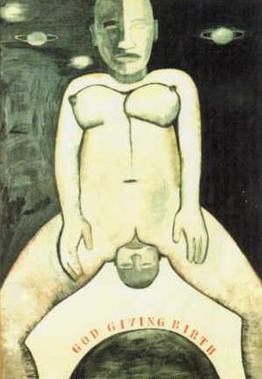
God Giving Birth is a 1968 painting by the Swedish artist Monica Sjöö. It shows a nude woman whose face is half dark and half light, with the head of a child emerging from her birth canal. Sjöö was an exponent of second-wave feminism and the Goddess movement. During the birth of her second son, she had inner visions that made her view motherhood in a religious light, and this inspired her to paint God Giving Birth.
First exhibited in the United Kingdom in 1970 and 1973, God Giving Birth drew criticism from Christian groups who accused it of blasphemy. It has been discussed by modern pagans as a religious image and among feminist scholars for its way of connecting spiritual and physical creation. It is in the collection of the Museum Anna Nordlander [sv] in Skellefteå, Sweden.
https://en.wikipedia.org/wiki/God_Giving_Birth
2 notes
·
View notes
Text
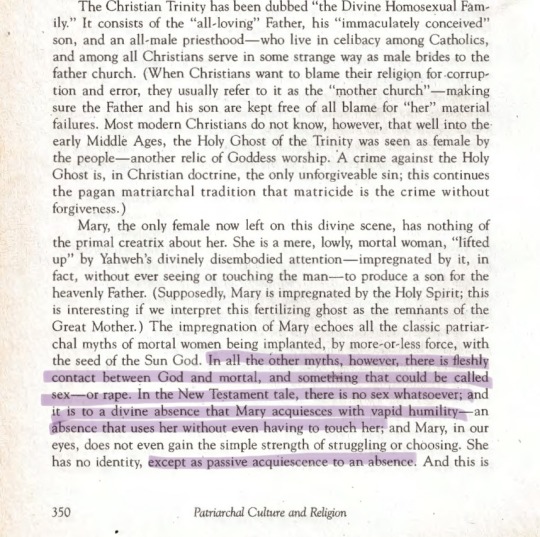

Monica Sjöö & Barbara Mor, The Great Cosmic Mother. pg350-351
1 note
·
View note